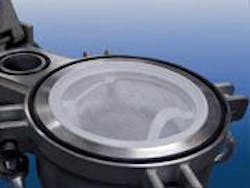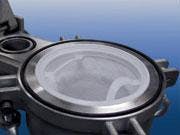Filter Bags – an Alternative to Filter Cartridges
By Tim Sheehan
Bag filters and cartridge filters often compete for use in commercial and industrial applications but it is often a point of contention as to which type of filter is the better choice. In many applications felt media bag filters can be the less-expensive alternative.
There are three types of bag filter media in general use: mesh, melt-blown and needled felt. Mesh bags generally use either monofilament or multi-filament fiber woven into a consistent mesh pattern and then heat-set to fix the pore size in place. Bags made with melt-blown material have multiple layers of melt-blown fabric. This fabric is composed of extremely thin extruded fibers laid down and fused together to form a material with an exact and consistent pore structure. Mesh and melt-blown bags depend on a precise surface-capture rather than a depth matrix of fibers to achieve their results and are beyond the scope of this discussion.
The bag filter most often considered as an alternative to a depth-filter cartridge is also a depth-filter type, one using needled felt media. This media is made on a machine called a needle loom. In this process a layer of tufted fibers called a batt is fed through the loom while a needle-board mounting thousands of barbed needles is repeatedly punched into the batt and withdrawn, leaving the fibers entangled.
A wide range of felt densities can be achieved by varying the fineness (denier) of the fiber, the advance rate and weight of the batt, the strokes per minute and the depth of penetration of the needles.
Better manufacturers of needled felt filter bags closely monitor various material parameters, including the denier of the fiber, weight per square yard, thickness, air permeability and burst strength. This ensures that repeatable results will be obtained. The net effect is that modern felt manufacturing techniques can produce felt filter media that will provide overall filtration performance in a wide range of applications, while being demonstrably superior to most depth-filter cartridges in terms of pressure drop, ease of use and cost of ownership.
A big advantage provided by bag filters, with their large inside diameter, is that they offer many times the surface area of a comparable depth cartridge.
That larger surface area provides a more wide open flow path, which generally means less flow friction and a lower pressure-drop across the filter. In most cases, too, bag filters generally have a lower start-up Differential Pressure (ΔP) allowing longer run times and a more effective use of available filter surface area.
Available surface area is always the most critical factor affecting filter performance. Having more surface area lowers a filter's startup ΔP and provides for more dirt holding capacity. To equal the surface area of just one #2 size (7 x 32-in.) bag filter you would need three 30-inch depth cartridges. In a typical cooling water application handling 90 gpm, you would need at least five 30-inch cartridges to handle the same flow as one double-length filter bag. (chart 1)
Another key point: All else being equal, fewer seals per filter mean less chance of dirt by-pass. Commonly used double open end style (DOE) depth cartridges have two sealing surfaces per cartridge. This means you have 110 seals on a cartridge filter handling the same flow as a bag filter with only 10 sealing surfaces. And, with bag collars equivalent to the Hayward Sentinel® ring, a seal able to accommodate 1-micron absolute rated filters can be achieved.
In comparing the relative benefits of using bag filters over depth cartridge filters, several factors should be considered:
Unit cost, the most obvious factor, usually favors the selection of a bag filter. As noted in the 90 gpm cooling water application mentioned earlier, it can take as many as five 30-inch cartridges to handle the same flow as one #2 size bag filter. Five 30-inch string-wound or spun polypropylene depth cartridges will normally cost between $30 and $45 per change-out. A good-quality bag filter that would handle the same load would cost only about $5.
Disposal of used filter media is another cost/convenience factor that is too often ignored, especially in applications where the filters treat hazardous waste. Generally, filters containing hazardous materials are put into 55 gallon drums and hauled away for burial in a land-fill. Since bag filters are much more compressible than cartridges, more of them can be packed into a single drum. Add to this the fact that fewer bags than cartridges are used per application and it becomes clear that disposal costs can usually be reduced by at least a factor of 10. Similar savings, though less dramatic, are also achieved in applications involving non-hazardous materials.
Storage space for spare-filter stock can also be a concern. Since bag filters require fewer change-outs than cartridges, and because they take up less space than cartridges, the amount of storage space required for any particular application is significantly less. Also, shipping costs, a large portion of the total delivered cost of cartridge filters, will be about 30% more than that of the equivalent bag filters.
Reduced labor costs are realized by the use of bag filters because they are easier and quicker to change-out. In fact, performing a change-out on a bag filter takes only about half the time required for a cartridge filter capable of handling a comparable flow rate. This time savings is partly due to saving the time needed to attach cartridge seal caps and hold-down springs and also because there are fewer bag filters to be changed.
Summary
Is a depth bag filter always a better choice than a depth cartridge filter? No, not necessarily. For example, cartridges should always be considered for low flow rate applications and where installation space is limited and also for extremely fine sub-micron filtration. But in many other applications the improvements in bag filter manufacturing techniques and materials engineering have made bag filters a viable option.
About the Author:
Tim Sheehan has 11 years of experience in the fields of potable water purification, microfiltration, and industrial process filtration both in the U.S. and Latin America. A graduate of Northwestern University, he is a Technical Sales Consultant and Product Manager with Hayward Industrial Products, headquartered in Elizabeth, NJ.


